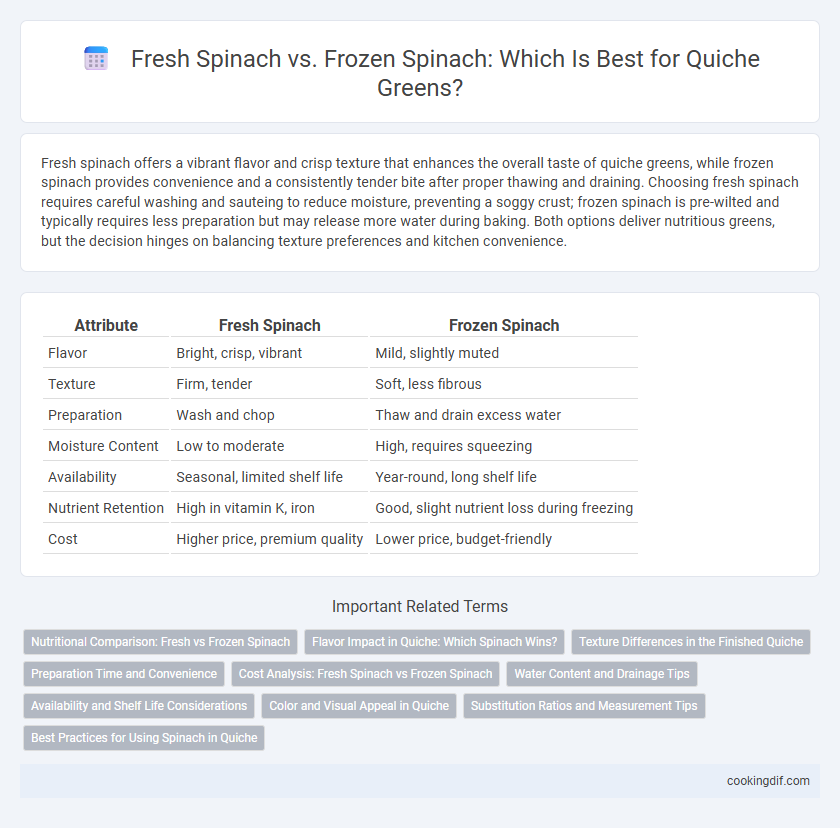Fresh spinach offers a vibrant flavor and crisp texture that enhances the overall taste of quiche greens, while frozen spinach provides convenience and a consistently tender bite after proper thawing and draining. Choosing fresh spinach requires careful washing and sauteing to reduce moisture, preventing a soggy crust; frozen spinach is pre-wilted and typically requires less preparation but may release more water during baking. Both options deliver nutritious greens, but the decision hinges on balancing texture preferences and kitchen convenience.
Table of Comparison
| Attribute | Fresh Spinach | Frozen Spinach |
|---|---|---|
| Flavor | Bright, crisp, vibrant | Mild, slightly muted |
| Texture | Firm, tender | Soft, less fibrous |
| Preparation | Wash and chop | Thaw and drain excess water |
| Moisture Content | Low to moderate | High, requires squeezing |
| Availability | Seasonal, limited shelf life | Year-round, long shelf life |
| Nutrient Retention | High in vitamin K, iron | Good, slight nutrient loss during freezing |
| Cost | Higher price, premium quality | Lower price, budget-friendly |
Nutritional Comparison: Fresh vs Frozen Spinach
Fresh spinach retains slightly higher levels of vitamin C and folate compared to frozen spinach, which can lose some nutrients during blanching and freezing processes. Frozen spinach, however, often contains similar or higher concentrations of iron, calcium, and fiber due to the preservation methods locking in these minerals. Both options provide essential nutrients for a quiche filling, but choosing fresh spinach offers a marginal advantage in antioxidant vitamin content.
Flavor Impact in Quiche: Which Spinach Wins?
Fresh spinach offers a vibrant, slightly sweet flavor that enhances the overall taste of quiche, providing a delicate texture that blends seamlessly with creamy eggs and cheese. Frozen spinach, often blanched before freezing, can lose some of its freshness and develop a milder, slightly earthy taste, which may result in a less pronounced flavor profile in quiche. For a superior flavor impact, fresh spinach generally wins by contributing brightness and a crisp green note that elevates the dish.
Texture Differences in the Finished Quiche
Fresh spinach provides a tender, slightly crisp texture that enhances the quiche's overall mouthfeel, while frozen spinach tends to release more water during cooking, resulting in a softer, sometimes soggier texture. Properly draining frozen spinach is crucial to minimize excess moisture and maintain the quiche's structural integrity. The choice between fresh and frozen spinach directly influences the final texture, making fresh spinach the preferred option for a balance of firmness and freshness in quiche greens.
Preparation Time and Convenience
Fresh spinach requires thorough washing, trimming, and sauteing to remove excess moisture, extending preparation time for quiche greens. Frozen spinach is pre-washed, chopped, and typically already blanched or steamed, allowing for faster thawing and reduced prep steps. Choosing frozen spinach streamlines the process, making it a convenient option for quick quiche preparation.
Cost Analysis: Fresh Spinach vs Frozen Spinach
Fresh spinach typically costs more per pound than frozen spinach, with prices varying seasonally and regionally, often making frozen spinach a more budget-friendly option for quiche greens. Frozen spinach offers longer shelf life and reduces waste, which can contribute to overall cost savings in meal preparation. While fresh spinach provides a slightly brighter flavor, the cost-effectiveness and consistent availability of frozen spinach make it a preferred choice for economical quiche recipes.
Water Content and Drainage Tips
Fresh spinach contains more water than frozen spinach, which can cause a soggy quiche crust if not properly drained. Frozen spinach typically releases excess moisture during thawing, so squeezing it thoroughly with a clean kitchen towel or using a salad spinner helps prevent excess water in the filling. Ensuring well-drained greens maintains a firm texture and enhances the overall consistency of the quiche.
Availability and Shelf Life Considerations
Fresh spinach offers a vibrant flavor and texture ideal for quiche but has limited shelf life, typically lasting around 3 to 5 days in the refrigerator, which can affect availability for consistent use. Frozen spinach provides greater availability year-round and extended shelf life, often lasting up to 8 to 12 months in the freezer, ensuring it can be stored in bulk without spoilage concerns. Choosing between fresh and frozen spinach depends on balancing the urgency of use with the convenience of storage and long-term availability for quiche preparation.
Color and Visual Appeal in Quiche
Fresh spinach enhances quiche with a vibrant, deep green color that elevates its visual appeal and signals freshness. Frozen spinach often releases excess moisture when cooked, leading to a duller color and a less distinct texture in the quiche. Choosing fresh spinach ensures bright, appealing greens that remain visually prominent after baking.
Substitution Ratios and Measurement Tips
Fresh spinach typically cooks down to about one-quarter of its volume, making 4 cups raw spinach equivalent to 1 cup cooked, whereas frozen spinach is already cooked and drained, so 1 cup frozen spinach directly substitutes for 1 cup cooked fresh spinach in quiche recipes. When measuring fresh spinach, loosely packed leaves ensure accurate volume without overstuffing, while thawed frozen spinach must be thoroughly squeezed to remove excess water to avoid soggy quiche crusts. For seamless substitutions, use a 4:1 raw-to-cooked ratio for fresh spinach and match weight when using frozen spinach--approximately 5 ounces frozen equals 5 ounces fresh cooked.
Best Practices for Using Spinach in Quiche
Fresh spinach offers a vibrant texture and flavor ideal for quiche, but it must be thoroughly washed, chopped, and sauteed to reduce moisture and prevent sogginess. Frozen spinach, already blanched and drained, provides convenience and consistency, but requires careful pressing or squeezing to remove excess water before adding to the quiche mixture. Using fresh or frozen spinach properly ensures optimal moisture control, preserving the quiche's structure and enhancing its taste.
fresh spinach vs frozen spinach for quiche greens Infographic

 cookingdif.com
cookingdif.com